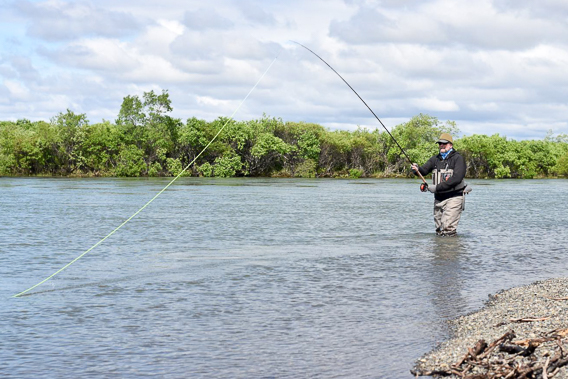Deneki Chronicles is an archive of past blog posts that are still relevant regardless of how old they are. They are timeless tips that will improve your fishing.

Over the last several years of hosting trips and spending days on the river almost exclusively with Spey anglers, I have become increasingly aware of the importance of overhang; the term used to describe the amount of running line left outside the rod tip during the cast. Adjusting the amount of overhang can greatly alter the feel of your rod and overall casting performance. However, I find many Spey anglers (both beginners and even highly experienced casters) often don’t pay enough attention to it.
Maintaining a Consistent Overhang
For those new to Spey casting, a great tip is to try a few different lengths of overhang and find a length that you are comfortable with. I find that most of the time an ideal length of overhang is about 12 inches (or 30 centimeters for us Europeans). To make sure you have the same overhang for every cast, try marking your running line with a permanent marker to your preferred length, at the point where you hold the running line against the cork of your rod before casting. If you make sure that mark is always under your holding finger you’ll have the same overhang outside your rod tip time and time again. This consistency of overhang length (and therefore the overall length of the head and tip used as well) will definitely help with maintaining a consistent casting stroke… After all, consistency is the key to great casting!
For experienced casters, however, it’s worth noting that altering our overhang for certain applications can help our casting as well as the presentation of our fly when required. It’s still a great idea to use the same length of overhang for the majority of casting throughout the day, but as variables change (i.e. wading depth, obstructions, etc.) we can try a few little tricks which can be a big help.
Shortening Overhang
Shortening the length of overhang actually reduces the arc that we create when sweeping during our cast. This also means with a smaller arc we create a smaller D-loop. This is beneficial for a number of reasons.
For starters, if we’re wading really deep and struggling to lift the tip on our forward stroke, shortening the amount of overhang can make a huge difference. Although we can raise our arms slightly throughout the sweep and forward stroke, we can also shorten the overhang so we have less line to move to still effectively load the rod (with less effort we might add).
If we’re stuck under a tree, against a steep riverbank, or any other obstruction which reduces the amount of backcast room, shortening the overhang will also reduce the D-loop we create on our backcast and will be less likely to tangle up. Often times, I even pull some of the head of my Spey line into the rings of my rod to create an even smaller D-loop in order to get a cast out into the river.
If there is a strong headwind into our face when casting, a shorter overhang can also help us create a tighter loop during the forward stroke. The smaller arc created when sweeping requires less movement and therefore is easier to create a tighter loop on our forward stroke. This tighter loop is more dynamic and will “cut” through the air resulting in more efficient casts with less effort.
Lengthening Overhang
On the other hand, increasing the amount of overhang will lengthen out the size of our D-Loop. Thus, this will increase our casting arc when loading the rod in a sweep. This can also be beneficial in several circumstances.
For example, if we need to bomb a long cast, lengthening the overhang will create a larger arc when we sweep. This is much easier to control if we aren’t wading too deep. The wider arc creates a longer sweep which will in effect give us more load. That load is released on the forward stroke resulting in longer casts. Simply put; longer overhang, longer cast (there is a point of diminishing return of course)
Also, if the wind is behind us, we can use a longer overhang to help us set our line in the wind to create a little more load with no extra effort. Just slightly raise the rod tip during the sweep to accommodate the extra line, this allows the wind to “catch” our line (basically like a sail on a ship) and actually load our rod for us. To accommodate this extra load we can slow down the sweep and apply just enough forward stroke to release that energy with a high stop of the rod tip. The wind will still catch the forward cast and turn over that tip and fly with much less effort than normal.
Disclaimer
Adjusting the length of overhang can be a great tool for a number of situations and conditions encountered on the water. That being said, unless you are an experienced Spey caster, I highly recommend sticking with the same amount of overhang to start in order to establish the consistency we all strive for.
Leave a Reply